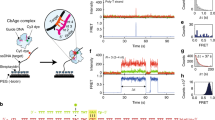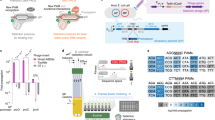Abstract
A paramount task in RNA interference research is to decipher the complex biology of cellular effectors, exemplified in humans by four pleiotropic Argonaute proteins (Ago1–Ago4). Here, we exploited DNA family shuffling, a molecular evolution technology, to generate chimeric Ago protein libraries for dissection of intricate phenotypes independently of prior structural knowledge. Through shuffling of human Ago2 and Ago3, we discovered two N-terminal motifs that govern RNA cleavage in concert with the PIWI domain. Structural modeling predicts an impact on protein rigidity and/or RNA-PIWI alignment, suggesting new mechanistic explanations for Ago3's slicing deficiency. Characterization of hybrids including Ago1 and Ago4 solidifies that slicing requires the juxtaposition and combined action of multiple disseminated modules. We also present a Gateway library of codon-optimized chimeras of human Ago1–Ago4 and molecular evolution analysis software as resources for future investigations into RNA interference sequence-structure-function relationships.
This is a preview of subscription content, access via your institution
Access options
Subscribe to this journal
Receive 12 print issues and online access
$189.00 per year
only $15.75 per issue
Buy this article
- Purchase on Springer Link
- Instant access to full article PDF
Prices may be subject to local taxes which are calculated during checkout





Similar content being viewed by others
References
Mukherjee, K., Campos, H. & Kolaczkowski, B. Evolution of animal and plant dicers: early parallel duplications and recurrent adaptation of antiviral RNA binding in plants. Mol. Biol. Evol. 30, 627–641 (2013).
Höck, J. & Meister, G. The Argonaute protein family. Genome Biol. 9, 210 (2008).
Hutvagner, G. & Simard, M.J. Argonaute proteins: key players in RNA silencing. Nat. Rev. Mol. Cell Biol. 9, 22–32 (2008).
Su, H., Trombly, M.I., Chen, J. & Wang, X. Essential and overlapping functions for mammalian Argonautes in microRNA silencing. Genes Dev. 23, 304–317 (2009).
Ender, C. & Meister, G. Argonaute proteins at a glance. J. Cell Sci. 123, 1819–1823 (2010).
Haussecker, D. et al. Human tRNA-derived small RNAs in the global regulation of RNA silencing. RNA 16, 673–695 (2010).
Ahlenstiel, C.L. et al. Direct evidence of nuclear Argonaute distribution during transcriptional silencing links the actin cytoskeleton to nuclear RNAi machinery in human cells. Nucleic Acids Res. 40, 1579–1595 (2012).
Parisi, C. et al. Ago1 and Ago2 differentially affect cell proliferation, motility and apoptosis when overexpressed in SH-SY5Y neuroblastoma cells. FEBS Lett. 585, 2965–2971 (2011).
Van Stry, M. et al. Enhanced susceptibility of Ago1/3 double-null mice to influenza A virus infection. J. Virol. 86, 4151–4157 (2012).
Randall, G. et al. Cellular cofactors affecting hepatitis C virus infection and replication. Proc. Natl. Acad. Sci. USA 104, 12884–12889 (2007).
Mockenhaupt, S., Schurmann, N. & Grimm, D. When cellular networks run out of control: global dysregulation of the RNAi machinery in human pathology and therapy. Prog. Mol. Biol. Transl. Sci. 102, 165–242 (2011).
Khan, A.A. et al. Transfection of small RNAs globally perturbs gene regulation by endogenous microRNAs. Nat. Biotechnol. 27, 549–555 (2009).
Grimm, D. et al. Fatality in mice due to oversaturation of cellular microRNA/short hairpin RNA pathways. Nature 441, 537–541 (2006).
Beer, S. et al. Low-level shRNA cytotoxicity can contribute to MYC-induced hepatocellular carcinoma in adult mice. Mol. Ther. 18, 161–170 (2010).
Grimm, D. The dose can make the poison: lessons learned from adverse in vivo toxicities caused by RNAi overexpression. Silence 2, 8 (2011).
Martin, J.N. et al. Lethal toxicity caused by expression of shRNA in the mouse striatum: implications for therapeutic design. Gene Ther. 18, 666–673 (2011).
Ehlert, E.M., Eggers, R., Niclou, S.P. & Verhaagen, J. Cellular toxicity following application of adeno-associated viral vector-mediated RNA interference in the nervous system. BMC Neurosci. 11, 20 (2010).
Bish, L.T. et al. Cardiac gene transfer of short hairpin RNA directed against phospholamban effectively knocks down gene expression but causes cellular toxicity in canines. Hum. Gene Ther. 22, 969–977 (2011).
Grimm, D. et al. Argonaute proteins are key determinants of RNAi efficacy, toxicity, and persistence in the adult mouse liver. J. Clin. Invest. 120, 3106–3119 (2010).
Diederichs, S. et al. Coexpression of Argonaute-2 enhances RNA interference toward perfect match binding sites. Proc. Natl. Acad. Sci. USA 105, 9284–9289 (2008).
Juvvuna, P.K., Khandelia, P., Lee, L.M. & Makeyev, E.V. Argonaute identity defines the length of mature mammalian microRNAs. Nucleic Acids Res. 40, 6808–6820 (2012).
Ma, J.B. et al. Structural basis for 5′-end-specific recognition of guide RNA by the A. fulgidus Piwi protein. Nature 434, 666–670 (2005).
Till, S. et al. A conserved motif in Argonaute-interacting proteins mediates functional interactions through the Argonaute PIWI domain. Nat. Struct. Mol. Biol. 14, 897–903 (2007).
Elkayam, E. et al. The structure of human Argonaute-2 in complex with miR-20a. Cell 150, 100–110 (2012).
Schirle, N.T. & MacRae, I.J. The crystal structure of human Argonaute2. Science 336, 1037–1040 (2012).
Frank, F. et al. Structural analysis of 5′-mRNA-cap interactions with the human AGO2 MID domain. EMBO Rep. 12, 415–420 (2011).
Frank, F., Sonenberg, N. & Nagar, B. Structural basis for 5′-nucleotide base-specific recognition of guide RNA by human AGO2. Nature 465, 818–822 (2010).
Liu, J. et al. Argonaute2 is the catalytic engine of mammalian RNAi. Science 305, 1437–1441 (2004).
Diederichs, S. & Haber, D.A. Dual role for argonautes in microRNA processing and posttranscriptional regulation of microRNA expression. Cell 131, 1097–1108 (2007).
Cheloufi, S., Dos Santos, C.O., Chong, M.M. & Hannon, G.J. A dicer-independent miRNA biogenesis pathway that requires Ago catalysis. Nature 465, 584–589 (2010).
Cifuentes, D. et al. A novel miRNA processing pathway independent of Dicer requires Argonaute2 catalytic activity. Science 328, 1694–1698 (2010).
Yang, J.S. et al. Conserved vertebrate mir-451 provides a platform for Dicer-independent, Ago2-mediated microRNA biogenesis. Proc. Natl. Acad. Sci. USA 107, 15163–15168 (2010).
Mallory, A.C. et al. Redundant and specific roles of the ARGONAUTE proteins AGO1 and ZLL in development and small RNA-directed gene silencing. PLoS Genet. 5, e1000646 (2009).
Zha, X., Xia, Q. & Yuan, Y.A. Structural insights into small RNA sorting and mRNA target binding by Arabidopsis Argonaute Mid domains. FEBS Lett. 586, 3200–3207 (2012).
Wang, B. et al. Distinct passenger strand and mRNA cleavage activities of human Argonaute proteins. Nat. Struct. Mol. Biol. 16, 1259–1266 (2009).
Yuan, Y.R. et al. Crystal structure of A. aeolicus argonaute, a site-specific DNA-guided endoribonuclease, provides insights into RISC-mediated mRNA cleavage. Mol. Cell 19, 405–419 (2005).
Crameri, A., Raillard, S.A., Bermudez, E. & Stemmer, W.P. DNA shuffling of a family of genes from diverse species accelerates directed evolution. Nature 391, 288–291 (1998).
Grimm, D. et al. In vitro and in vivo gene therapy vector evolution via multispecies interbreeding and retargeting of adeno-associated viruses. J. Virol. 82, 5887–5911 (2008).
Hartley, J.L., Temple, G.F. & Brasch, M.A. DNA cloning using in vitro site-specific recombination. Genome Res. 10, 1788–1795 (2000).
Valdmanis, P.N. et al. Expression determinants of mammalian argonaute proteins in mediating gene silencing. Nucleic Acids Res. 40, 3704–3713 (2012).
Joern, J.M., Meinhold, P. & Arnold, F.H. Analysis of shuffled gene libraries. J. Mol. Biol. 316, 643–656 (2002).
Gu, S. et al. Thermodynamic stability of small hairpin RNAs highly influences the loading process of different mammalian Argonautes. Proc. Natl. Acad. Sci. USA 108, 9208–9213 (2011).
Petri, S. et al. Increased siRNA duplex stability correlates with reduced off-target and elevated on-target effects. RNA 17, 737–749 (2011).
Winter, J. & Diederichs, S. Argonaute proteins regulate microRNA stability: increased microRNA abundance by Argonaute proteins is due to microRNA stabilization. RNA Biol. 8, 1149–1157 (2011).
Wang, Y. et al. Nucleation, propagation and cleavage of target RNAs in Ago silencing complexes. Nature 461, 754–761 (2009).
Kwak, P.B. & Tomari, Y. The N domain of Argonaute drives duplex unwinding during RISC assembly. Nat. Struct. Mol. Biol. 19, 145–151 (2012).
Nakanishi, K., Weinberg, D.E., Bartel, D.P. & Patel, D.J. Structure of yeast Argonaute with guide RNA. Nature 486, 368–374 (2012).
Janas, M.M. et al. Alternative RISC assembly: binding and repression of microRNA-mRNA duplexes by human Ago proteins. RNA 18, 2041–2055 (2012).
Djuranovic, S. et al. Allosteric regulation of Argonaute proteins by miRNAs. Nat. Struct. Mol. Biol. 17, 144–150 (2010).
Hur, J.K., Zinchenko, M.K., Djuranovic, S. & Green, R. Regulation of Argonaute Slicer activity by guide RNA 3′ end interactions with the N-terminal lobe. J. Biol. Chem. 288, 7829–7840 (2013).
Pillai, R.S., Artus, C.G. & Filipowicz, W. Tethering of human Ago proteins to mRNA mimics the miRNA-mediated repression of protein synthesis. RNA 10, 1518–1525 (2004).
Schmitter, D. et al. Effects of Dicer and Argonaute down-regulation on mRNA levels in human HEK293 cells. Nucleic Acids Res. 34, 4801–4815 (2006).
Stoehr, J. & Meister, G. In vitro RISC cleavage assay. Methods Mol. Biol. 725, 77–90 (2011).
Thompson, J.D., Higgins, D.G. & Gibson, T.J. CLUSTAL W: improving the sensitivity of progressive multiple sequence alignment through sequence weighting, position-specific gap penalties and weight matrix choice. Nucleic Acids Res. 22, 4673–4680 (1994).
Roberts, E., Eargle, J., Wright, D. & Luthey-Schulten, Z. MultiSeq: unifying sequence and structure data for evolutionary analysis. BMC Bioinformatics 7, 382 (2006).
Leaver-Fay, A. et al. ROSETTA3: an object-oriented software suite for the simulation and design of macromolecules. Methods Enzymol. 487, 545–574 (2011).
Kim, D.E., Chivian, D. & Baker, D. Protein structure prediction and analysis using the Robetta server. Nucleic Acids Res. 32, W526–W531 (2004).
Humphrey, W., Dalke, A. & Schulten, K. VMD: visual molecular dynamics. J. Mol. Graph. 14, 33–38, 27–28 (1996).
Benjamini, Y. & Hochberg, Y. Controlling the false discovery rate: a practical and powerful approach to multiple testing. J. Roy. Statist. Soc. Ser. B 57, 289–300 (1995).
Acknowledgements
The authors greatly appreciate funding of their group and work by the Heidelberg University Cluster of Excellence CellNetworks (grant number EXC 81) as well as by the Chica and Heinz Schaller Foundation. L.G.T. was supported by an European Molecular Biology Organization fellowship (EMBO ALTF 676-2010). We moreover thank H.-G. Kräusslich, R. Bartenschlager, G. Stöcklin and all lab members for helpful discussions and suggestions. In addition, we are indebted to S. Ruedel (University of Regensburg, Regensburg, Germany) for kindly providing her protocol for slicer assays as well as to W. Filipowicz (Friedrich Miescher Institute for Biomedical Research, Basel, Switzerland) for his much appreciated gifts of Ago2-knockdown cells and of various plasmids for the tethering assays. Finally, we are grateful to E. Wiedtke for technical support as well as to S. Grosse for her extensive critical testing of our Salanto software and for providing sundry useful ideas for improvements.
Author information
Authors and Affiliations
Contributions
N.S. and D.G. designed the experiments in this work and wrote the manuscript. N.S. conducted all experiments. L.G.T. and R.B.R. contributed the Ago2 and Ago3 Rosetta models and assisted in their interpretation. C.B. performed the bioinformatical analyses of the DFS reactions and products, using the Salanto software tool that he, together with N.S., developed for this work.
Corresponding author
Ethics declarations
Competing interests
The authors declare no competing financial interests.
Supplementary information
Supplementary Text and Figures
Supplementary Figures 1–7 and Supplementary Tables 1–4 (PDF 7067 kb)
Rights and permissions
About this article
Cite this article
Schürmann, N., Trabuco, L., Bender, C. et al. Molecular dissection of human Argonaute proteins by DNA shuffling. Nat Struct Mol Biol 20, 818–826 (2013). https://doi.org/10.1038/nsmb.2607
Received:
Accepted:
Published:
Issue Date:
DOI: https://doi.org/10.1038/nsmb.2607



